HOW long does rain last in country baked dry? That’s a question concerning pastoralists in NSW’s Western Division following two consecutive years of low rainfall and a summer of searing temperatures. Now they’re working with ecologists in new joint efforts to restore the country’s ability to absorb rain in readiness for when the drought breaks.
“Our country is just like the Sahara Desert,” says third-generation pastoralist Barry Turner, who with his wife Annette runs the 26,500-hectare Polpah Station, 13km east of White Cliffs.
“We haven’t had good rain for probably three years. September 2016 was the last time we had green feed. It’s as bad as I’ve ever seen it.”
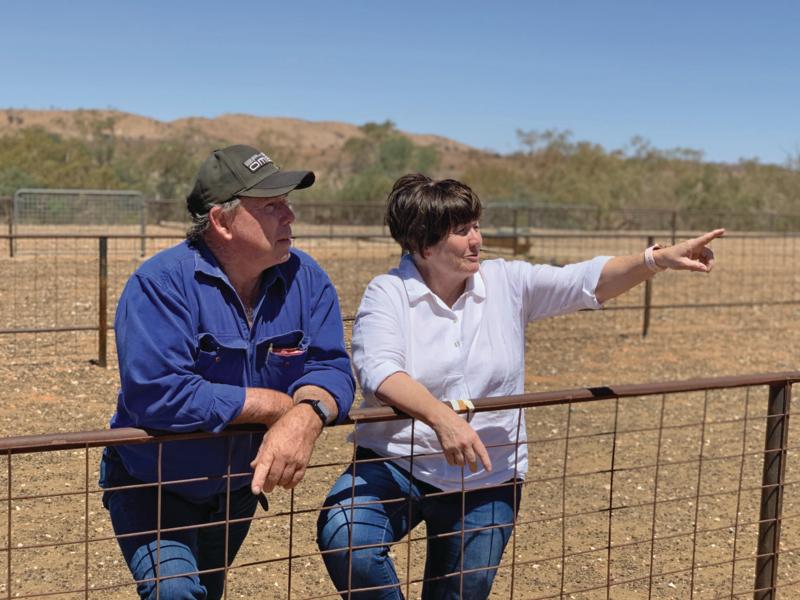 Barry and Annette Turner of Polpah Station, near White Cliffs
Barry and Annette Turner of Polpah Station, near White Cliffs.
Concerned that rain was increasingly sheeting across their eroded country without sinking in, thanks to deepening gullies, expanding scalds and other erosion, Barry and Annette and other Western Division landholders began land regeneration works three years ago, using an approach called
Ecosystem Management Understanding (EMU). It aims to increase rain infiltration and reduce run-off, erosion and topsoil losses.
Working in groups of up to six neighbouring landholders, the priority is to manage water flow, open up the land to slow the flow and encourage rainfall absorption to build subsoil moisture and encourage vegetation to grow, leading EMU scientist Dr Hugh Pringle says.
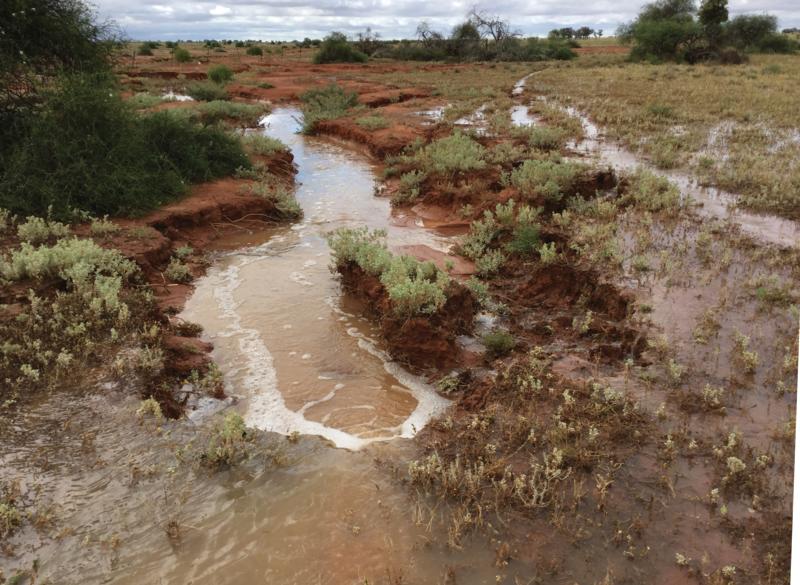 Water is wasted when it runs down erosion gullies instead of soaking into flood plains.
Water is wasted when it runs down erosion gullies instead of soaking into flood plains.
“They want to turn their stations back into spongy landscapes where the rain goes into soil locally and the soil stays wet for longer,” Dr Pringle says.
“That’s at the base of it all. They want to increase the length of their growing season and reduce the intensity of dry periods.” – Dr. Hugh Pringle
How EMU Land Management is implemented
The principles of EMU were first developed Dr Ken Tinley in sub-Saharan Africa. He and Dr Pringle then consolidated them in a research project in Australia. They’ve been used to reclaim desert in Africa and Saudi Arabia and to regenerate vegetation in the Gascoyne-Murchison Rangelands in Western Australia and in South Australia around Oodnadatta, the Gawler and northern Flinders Ranges.
RELATED:
Reaping the rewards of biodynamic farming
Using landholders’ knowledge of the land, Dr Pringle first meets with them, then asks them about the area’s history, their grazing management and long-term enterprise aims. Then he asks them to map their country, marking productive and unproductive areas, problems spots, creek lines, dams, water points and other key infrastructure and landmarks like roads. Then he’ll walk parts of it and often fly over it with them, sharing understanding of the ecology and geomorphology.
Together they develop land restoring or conserving projects and it’s left to the landholder to choose which to do first.
Dr Pringle, a landscape ecologist and geomorphologist, is overseeing its implementation in the Western Division at landholders’ requests, accompanied by the Western Local Land Services’ rangelands rehabilitation officer Paul Theakston.
Paul designs erosion control works, marks out contour lines and supervises earthworks. His HiLux ute carries the receiving mast for a laser level that receives signals that determine where works need to be done. He then uses a tine marker to scratch the ground accordingly with rip marks for a grader or dozer driver to follow.
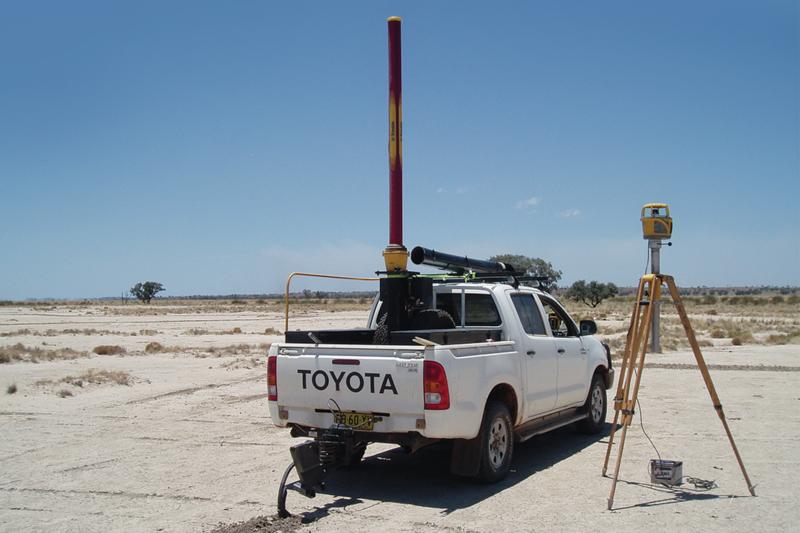 The survey vehicle Paul Theakston uses to mark out lines for earth-moving machinery operators to follow.
The survey vehicle Paul Theakston uses to mark out lines for earth-moving machinery operators to follow.
Land management methods to prevent soil erosion
Key methods to halt erosion include placing check banks across gully heads and across the gullies themselves to slow water flow and in some instances to stop silt flowing down gullies into dams. Paul says he’s seen dams reduced from depths of six to two metres after silt has flowed down deepening gullies into dams.
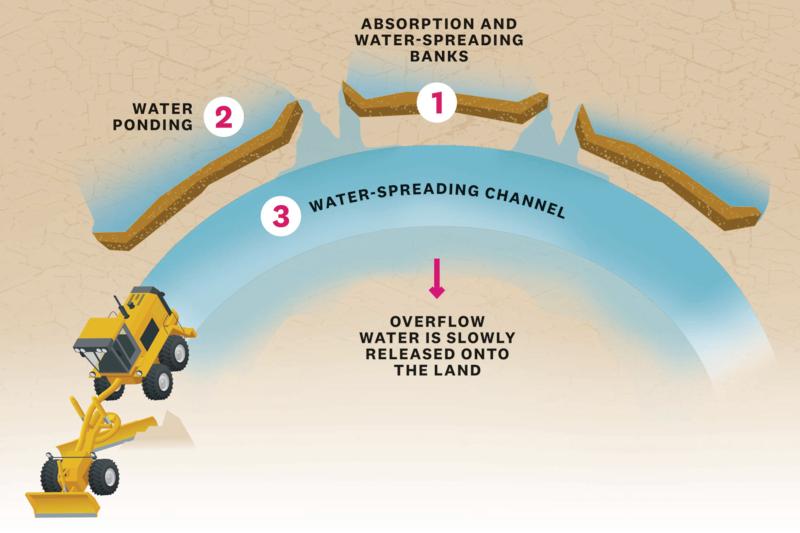 DIAGRAM KEY:
1. Absorption and water-spreading banks:
DIAGRAM KEY:
1. Absorption and water-spreading banks: These banks stop stormwater from quick run-off, preventing soil erosion and maximising the absorption of rainfall.
2. Water ponding: As rainwater ponds at the banks, it is slowly absorbed and any excess is diverted into the water channels.
3. Water-spreading channel: This helps spread water around the land. As the channel fills, the overflow is slowly released onto the land, reducing the erosive power of the water.
“First you get rid of the silt out of the dam then I’ll walk upstream to see where the silt is coming from and design check banks to go across the gullies. The aim is to have land sloping 20cm every 100m. At that gradient, the water hits the check bank and then slowly goes into the dam [without silting it up].”
RELATED:
Floating solar panels on farm dams
Scalded areas are recontoured to encourage water ponding. This is based on Australian research which showed that high soluble salt levels in scalds inhibited vegetation growth. It found those salt levels could be reduced to levels that allowed pasture and crop species to grow within a year of the ponds being established.
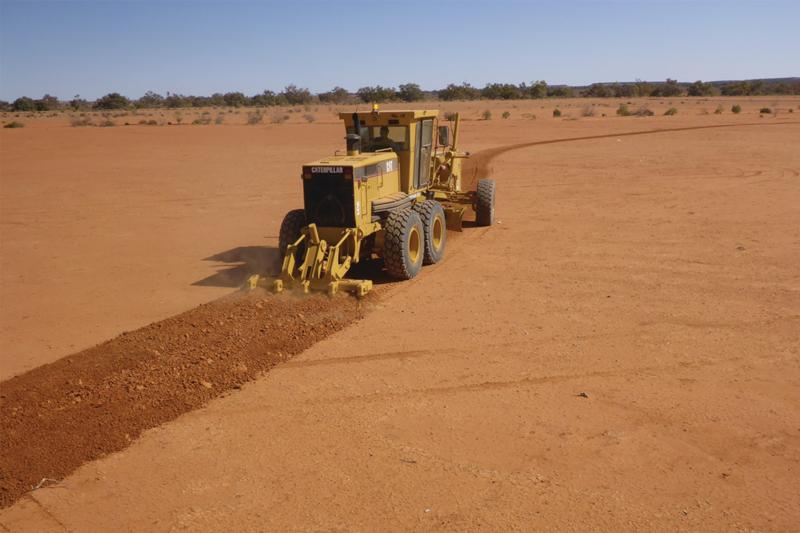 Barry Turner rips scalded ground on Polpah Station with his grader to improve water infiltration, done in conjunction with water ponding.
Barry Turner rips scalded ground on Polpah Station with his grader to improve water infiltration, done in conjunction with water ponding.
“You can often fix things immediately,” Dr Pringle says. “If a gully is getting longer and deeper and starting to kill the landscape, we can get in there and knock the problem on the head in a few days to a week. Then all the country above it will be saved. That’s often overlooked. It’s not just what you do to regenerate and get better pasture. It’s also about what country you can save by stopping problems emerging.”
Baking hot soils prevents water infiltration
Despite the long drought, demand for EMU has been big. Ten station leaseholders who manage more than 300,000 hectares between them have adopted EMU and a further six have lined up for this year. “I’ve been flat out and this year I’m getting an offsider [an additional employee] because more and more people want this work done,” Paul Theakston says.
RELATED ARTICLES ON DROUGHT:
-
Drought declarations: for or against?
-
The truth about the Murray-Darling
-
Building resilience to drought
-
Climate change wreaking havoc
With no significant rain to show results since work started on Polpah Station, the return on investment is unknown. Yet Barry Turner, who has 500 sheep left after de-stocking about 8,000 over the past few years, is so convinced of its likely impact, he bought a $170,000 20-tonne grader and set to work. He’s ripped up and recontoured about 200ha, but wants to do 10 times that before he’s done.
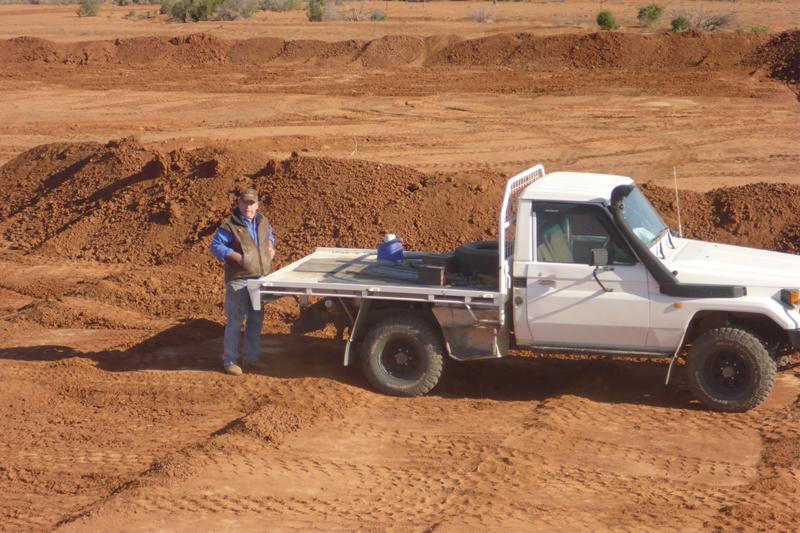 Barry next to banks designed to take water out of a gully and onto stable flood plain.
Barry next to banks designed to take water out of a gully and onto stable flood plain.
He estimates it could cost up to $250,000 and take another five to six years, but with up to 20-25% of Polpah Station no longer productive even in a good season, with most of it claypans and ironstone country, he’s sure it’s a worthwhile investment.
Source: Local Land Services (LLS).
“We have to start to do something, otherwise within 25 to 50 years it will be a desert the ways things are going,” Barry says. “There are areas starting to get damaged, and if I can get in before it gets too bad I can preserve it. It won’t help me much but whoever is here next will hopefully benefit from it.”
His wife Annette adds there have been high surface temperatures of 60-71°C recorded.
"The temperatures are baking the soil so the water isn’t getting down. It has the potential to change the molecular structure of the soil.” – Annette Turner
Barry has noticed in recent decades that rain tends to arrive in wild thunderstorms dumping big volumes quickly and rushing across scalded areas, carving already-eroded gullies deeper and rushing away without sinking in, leaving the subsoil chip-dry. And that means no feed grows. There’s nothing to hold the soil together and away it blows.
RELATED ARTICLES ON THE ENVIRONMENT:
-
Riverina family passionate about soil conservation
-
105 years of farming success in far-west NSW
-
Improving pasture growth with carbon grazing
-
Sustainable Merino farm turns to perennial grasses
“We never had thunderstorms like we get now,” he says. “In 1992 we had 127mm in an hour but as a child I remember getting more like 152mm, but it’d be over three or four days, just steady soaking rain.”
In 2012 Barry saw something that really worried him. “We had 254mm of rain over a week and within a few weeks of that we had no subsoil moisture. I didn’t know what to do. We have floodplains that were starting to erode because we were having really heavy rains and lots of them and they were creating damage, carving out gullies. The rain just ran off before it could soak in.”
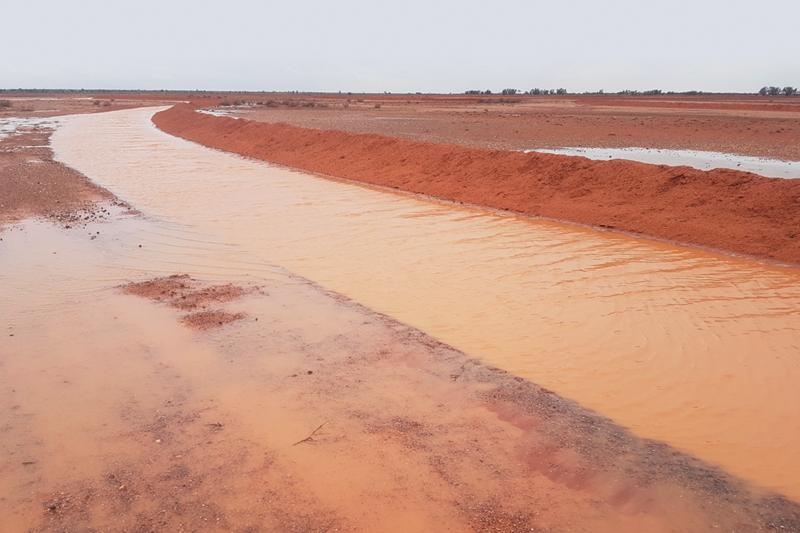 The main aim of EMU is to increase rain infiltration into soil and reduce run-off, erosion and topsoil losses.
Research to help rejuvenate sub-soil moisture
The main aim of EMU is to increase rain infiltration into soil and reduce run-off, erosion and topsoil losses.
Research to help rejuvenate sub-soil moisture
About 200km west of Polpah Station as the crow flies is the Fowlers Gap Arid Zone Research Station, managed by the University of NSW. There scientists study everything from meteors, atmospheric dirt levels, soil temperatures, vegetation and small animals to how large herbivores such as sheep, cattle, goats, camels and
kangaroos affect the landscape.
Three 400sqm exclusion zones have been fenced off to large herbivores, one for 30 years, one for four years and the other for two years. The aim is to see how long it takes the vegetation to recover. Research station director Dr Keith Leggett says the 30-year exclusion zone has vegetation as good as ever. And the other two zones are showing signs of recovery.
RELATED:
100km exclusion fence line revives productivity
“It shows the vegetation will recover even in an arid situation as long as there are no large herbivores on it,” Dr Leggett says. But excluding stock is cost prohibitive. Plus it would likely mean an increase in animals such as kangaroos, making land management even more complex and challenging, he adds.
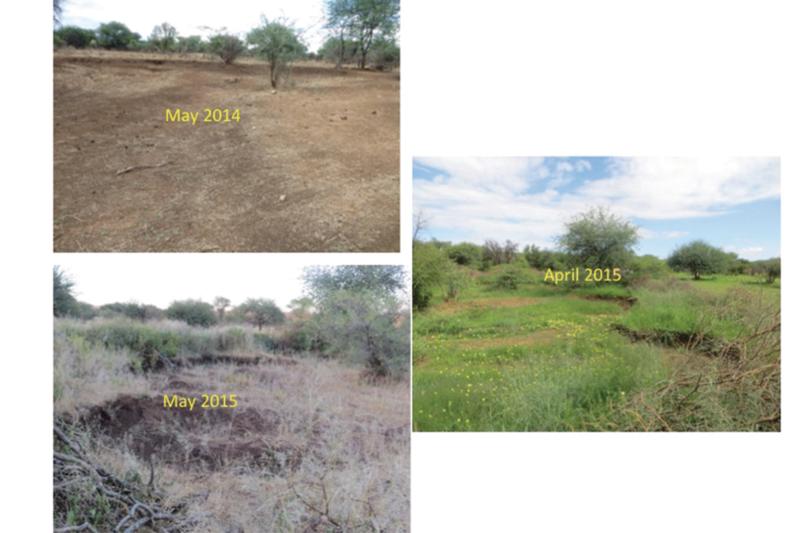 Before and after: EMU-led restoration of grassland in Namibia. Source: Dr. Hugh Pringle from http://www.emulandrecovery.org.au/.
Before and after: EMU-led restoration of grassland in Namibia. Source: Dr. Hugh Pringle from http://www.emulandrecovery.org.au/.
Records at Fowlers Gap show the average annual rainfall over 51 years is 230.7mm but there’s a high interannual variability meaning any year can vary from that average by up to 80%, Dr Leggett says.
“In 2017 we recorded 84.4mm, in 2018 it was 48.2mm. We have had a single year as low as this before but we haven’t had two years as low as this back to back.” Another year of low rain could be devastating. “What kills animals in drought is lack of vegetation. If we get another bad year we’d see a drastic decline in the numbers of small animals.”
Dr Leggett cautions that the region is facing shorter wetter periods followed by longer dryer periods. “We have to re-evaluate how we manage the land if we are going to get through these cycles.”
Meanwhile the landholders continue the EMU work. “It’s given us a lot of hope and encouragement that we will be able to restore sub-soil moisture,” Annette Turner says.
“When the good rains come, that’s when it will be exciting to see.”